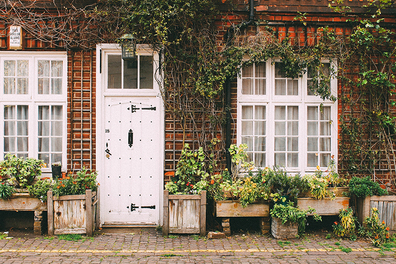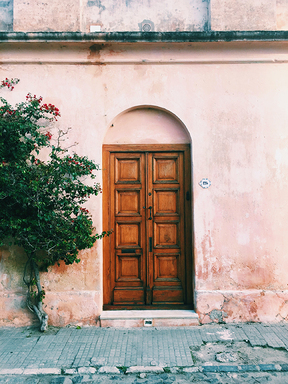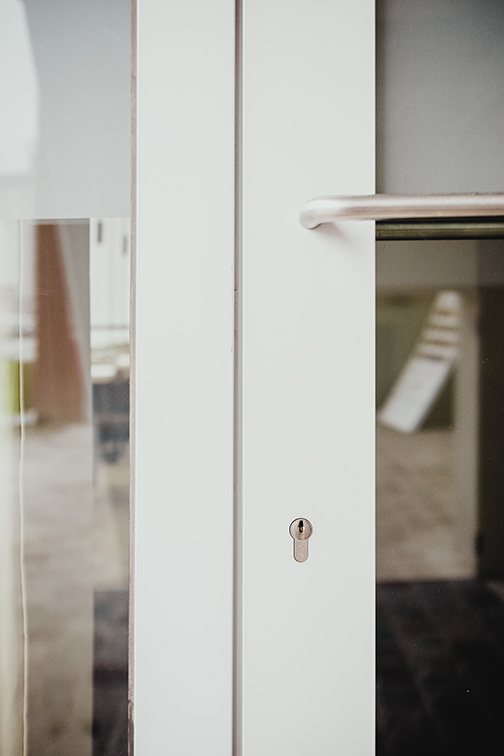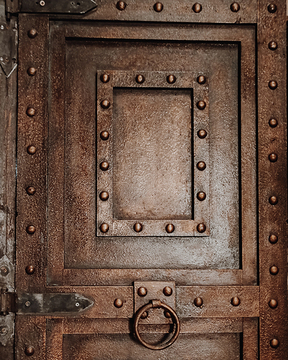Guide to Door Reinforcement
Link Copied

Imagine waking up in the middle of the night to the sound of someone trying to open your front door. It is unmistakable: the handle jiggles for a moment before you hear a dull slam. Slam after slam, you know what is happening now: someone is trying to break down your door to gain entry. If you do not have anything else to protect yourself and your family with, this would sap your peace of mind away in an instant.
Home security is something that isn’t often thought of until someone invades and steals the things you own. The average cost of a burglary to homeowners and renters is $2000 to $3000 dollars, and the average burglary only takes about eight minutes. Security cameras can help identify home invaders, but the truth is that only roughly 13% of burglary cases are successfully investigated by police. With the knowledge that the protection of you, your family, and your property is largely up to you, how do you start ensuring that your home is protected from intrusion? Let us start with the first line of defense that your home has: exterior doors.
Types of Door Reinforcements
You may be imagining a cartoon where the plucky characters nail a dozen boards against the door to prevent something nasty from getting inside. While this method is not exactly great for your wall’s paint job, Daffy Duck does have a point: the better reinforcement equipped to your door, the less chance there will be of an intruder breaking down the door.
Perhaps the main reason very few people invest in home security is the perceived cost. But modern advances in home security and automation, and the availability of DIY equipment from hardware stores have brought the pricing of good quality parts and equipment down to levels where any family or individual can take action. Combined with good security habits such as locking doors when you leave your home and securing unlocked windows, you would be surprised at how simple it is to safeguard your home. You have a few options when it comes to making your door an impenetrable defense:
-
Jamb reinforcement. Instead of relying solely on your door frame’s edge, an augment of this type is designed to take an immense amount of abuse. This is useful because the bar uses the entire door jamb surface area to take the brunt of any force instead of only the parts on the door being forced open. These can come separately or in a door reinforcement kit. The kits may save you money as opposed to buying all of the parts you need separately.
-
Door security equipment. In combination with the steel door edge bar, your door and door jamb reinforcement work in tandem to seal any locked door.
-
Strong pick-resistant locks and deadbolts. These are a no-brainer, as brand-new locks will perform much better over worn ones. New locks will also provide stiffer resistance to anyone with lockpicks.
-
Brand-new strike plates. Strike plates, the metal object through which a deadbolt is secured , provides yet another level of security by holding the deadbolt and the door shut with a pair of screws drilled horizontally into the wall of your home or apartment.
-
Tough steel door hinges. A door is typically more likely to buckle on the edge opposite the hinges, but it does not hurt to cover all of your bases, as you can see in this startling video above of burglars breaking straight through weakened hinges and into a home.
-
Finally, the material of your door. While this may not be easy to replace (if you live in an apartment, or require custom doors for an older home, for example), a strong hardwood or metal door will provide the maximum protection. Doors with decorative glass may be less secure depending on the construction. Additionally, security doors designed to withstand force can be installed on your home; storm doors, sliding doors, and steel screen doors offer great protection.
According to the Bureau of Justice, 34% of people counted in their annual survey said they reported the burglary that happened on their property to the authorities. The main reason they did not contact police is that they did not think law enforcement would be able to help them. Worse, violent crime and property crime often go hand in hand, especially when owners of the property discover the perpetrator in the act. With this in mind, here is what you should look for when purchasing reinforcement equipment and how to install them on your exterior doors.

How to Reinforce a Door
Let us equip your exterior door with the “door armor” they need to prevent unwanted intrusion. If you are worried that door security will mean sacrificing style for safety, you might be pleasantly surprised to find that modern locks, hinges, and reinforcement equipment are designed to seamlessly integrate into your door. Burglars will probably not even notice the difference between a reinforced door and a normal one besides the fact that they can not barge right in.
Door Frame Reinforcement
The design of door jamb reinforcement is surprisingly simple. A steel bar as long as the vertical height of the door frame’s edge is screwed into the jamb (which usually come with very long screws that tightly secure the bar to the door). The bar is called a jamb shield, and the kit can be customized to come with steel hinge and lock shields. Again, the purpose of door jamb security is to make it so intruders have to break your entire door frame for entry instead of the locks alone. If you worry about your door frame being a weak spot, this type of reinforcement is exactly what you need.
Door frame bars feature several stamped areas you can remove to fit the height of your door’s locks. In order to install door armor correctly, you will require a sufficient amount of space between your door and your door frame depending on the thickness of the bar. Most are 16 to 14-gauge in thickness, about the width of two quarters. So long as you have that amount of room, you won’t have any problems adding this security to your frame.

Reinforcement Lock Types
You may think door knobs and deadbolts the only two types of locks. Fortunately, there are almost as many locks as there are styles to go with them. Each design has different advantages and disadvantages, and here are just a few you can choose from:
- Entry door knobs. These are the most common, coming in circular or egg-shaped designs. Each has a lock in the center of the handle. While these are stylish and relatively inexpensive, these can be the most susceptible to lockpicking (depending on the brand and the age of the handle). Brand-new door knobs are more resistant, especially if they are made of materials like steel or nickel-plated metal.
- Lever door handles. These handles make opening a door very easy, especially if you have a bundle of groceries in both arms! These handles may or may not feature a lock at the center, especially if they are thumb-lever handles. A workaround could feature a separate lock above the lever in addition to a deadbolt (if installed).
- Mortise locks. If you are looking for a door handle and lock designed to take maximum punishment, a mortise lock is what you need. These locks are installed into custom security doors, inserted into a cubic hollow inside the door in such a way that the door handle and lock become a solid part of the door. These locks may feature a double or even triple cylinder deadbolt lock in combination. Often used to secure public and private buildings (especially back doors), their one downside is the cost of a custom door to fit the lock. As the lock itself is intrusive into the door, they do not often come installed in stylized doors.
- Deadbolt locks. These maximum-security locks come standard with single or double cylinder functions, connecting the door to the door frame. Most homes have holes drilled in the frame to accommodate these important locks, although for double cylinder locks additional holes may need to be drilled to fit. Lockpicking of deadbolts is generally difficult due to the force required to move the weight of the bolt (or bolts). Deadbolt locks are installed by inserting the cylinder through the hole out the side of the door. Then, align the turning assembly rods attached to the front plate by connecting the front plate and the rear plate through the connecting holes in the cylinder assembly. The bolt should retract and extend if both sides are inserted correctly. Then screw in all components and you are done!
- Electronic door locks. In recent years, these locks have skyrocketed in popularity due to their usefulness and reliability. Just as simple to install as regular locks, they come standard with a push-button keypad that can be programmed with a numerical code for easy entry. Some feature backup key locks in case the passcode is forgotten. Just never forget to keep your code secret!
- Smart locks. Just like electronic locks, these handles and door knobs are simple to install. These offer a unique feature: instead of using a key or a passcode to enter, all you need is a key fob or an app on your smartphone to unlock. These locks can even be remotely unlocked from any location where you have access to the internet. In combination with door security cameras, these are a great way to ensure every person who enters your home is allowed by you personally.
As we will discuss other pieces of equipment that will benefit the security of your door, a lock and a door jamb are two of the most important places to start. A reliable frame and a reliable lock will do wonders for home security, and they are very easy to install. There is a good chance that you will only need a drill or a screwdriver to get the job done right.

Importance of a Door Reinforcement
This frightening scenario happens more often than it should, and it even happens in broad daylight. The good news, according to current FBI Uniform Crime Reporting Statistics, is that the act of home invasion and burglary has dropped overall in the past four years. The bad news is that 2.5 million burglaries still occur annually in the United States, with 66% of them being home invasions and break-ins. 1.5 million burglaries happen in the middle of the day when the homeowner has gone to work, and 1.3 million occur at night, burglars utilizing the shroud of darkness to conceal their actions. You may think a well-lit apartment complex would help keep your apartment from being invaded, but home invasions are just as likely to happen to apartments as single residential homes (for good information on how to make your home or apartment more secure beyond simple door security, consider security system from Cove).
Fortunately, with all of the excellent types of defences installed on your outside doors, burglars and home invaders will find it very difficult to barge in unannounced. Besides the obvious purpose of door security, the whole idea behind home security is to discourage anyone from trying to break-in by making the process take longer than is profitable. The number one way burglars enter a home is through an unlocked door, followed by entering a first-level window; the one thing that home invaders do not want to do is make any loud sounds that alert neighbors to their presence. The front and back doors shield your home. Just remember to always lock your doors when you leave for the day so they can perform their necessary function.
Although it may seem too simple, the right door lock, door jamb reinforcement plate, and hinges can make all the difference in whether you become a victim or not. As you can see from this news report from Las Vegas, even the right size of screws can literally make or break a door.
Speaking of small but reliable pieces of equipment, here are a few other excellent reinforcement pieces we recommend.
Best Door Reinforcements
The Bureau of Justice releases annual reports on crime statistics, and unlike other types of crime that have fallen in previous years, physical violence and property crime have risen at a similar rate. You never know what a burglar is going to do if they discover you or your family members inside your own house when they break in, and you have no defense other than the failed locks on your house to protect you, you never know what can happen. Because of this, we recommend installing a security system with window and door sensors to help scare off intruders as well as ensure that the authorities know to come to your aid.
As stated before, the best door reinforcements — a jamb shield and a reliable set of locks — are only the first parts you need to secure your outside doors. Here are additional features you should consider installing as well.
Installing Brand New Strike Plates
Put simply, a strike plate is the metallic piece installed on the jamb where the cylinder of your locks enter the frame. Without a strike plate, the lock would be secured only by the jamb, which is a vulnerable location for the door to buckle. Strike plates come in a variety of shapes, from the typical plates you see in regular residential home doors to complex plates designed for specialty locks like mortise locks and multiple cylinder deadbolt locks. Lock sets typically come with their own strike plates. This is advantageous as they will match the style and shape of your lock. The size of screws that come with your lock set may vary, however. For better security, you may consider longer screws. If your door frame does not feature a hole wide enough for the strike plate and lock cylinder to fit, you may require a drill to bore a hole wide enough. Fortunately, the height of door locks and strike plates in newer houses are standardized to make installation easy. Such a small piece of metal serves a great purpose in keeping doors sealed tight.
Reinforcement For Your Hinges
Hinges come in a variety of different materials to match the style of your home’s doors. While brass, steel, stainless steel, aluminum, chrome, and nickel don't usually make a difference in keeping your doors secure, they vary in strength, which is something that you should consider. Aluminum and brass are easily bent with enough force. Steel and stainless steel have high resistances. Nickel is extremely resilient and inflexible. The stronger the hinges (and the deeper the screws), the less likely any intrusion will be successful.
Door hinges are an important part of your door’s defense; connected to your home with three inch screws or longer, your hinges provide the strength required to hold that edge in place. Even if you doubt the reliability of your door’s frame, long screws inserted and installed in all available screw holes will provide maximum protection.
Ready to get started?
Take this short quiz to build your customized system today!
Takes less than a minute


